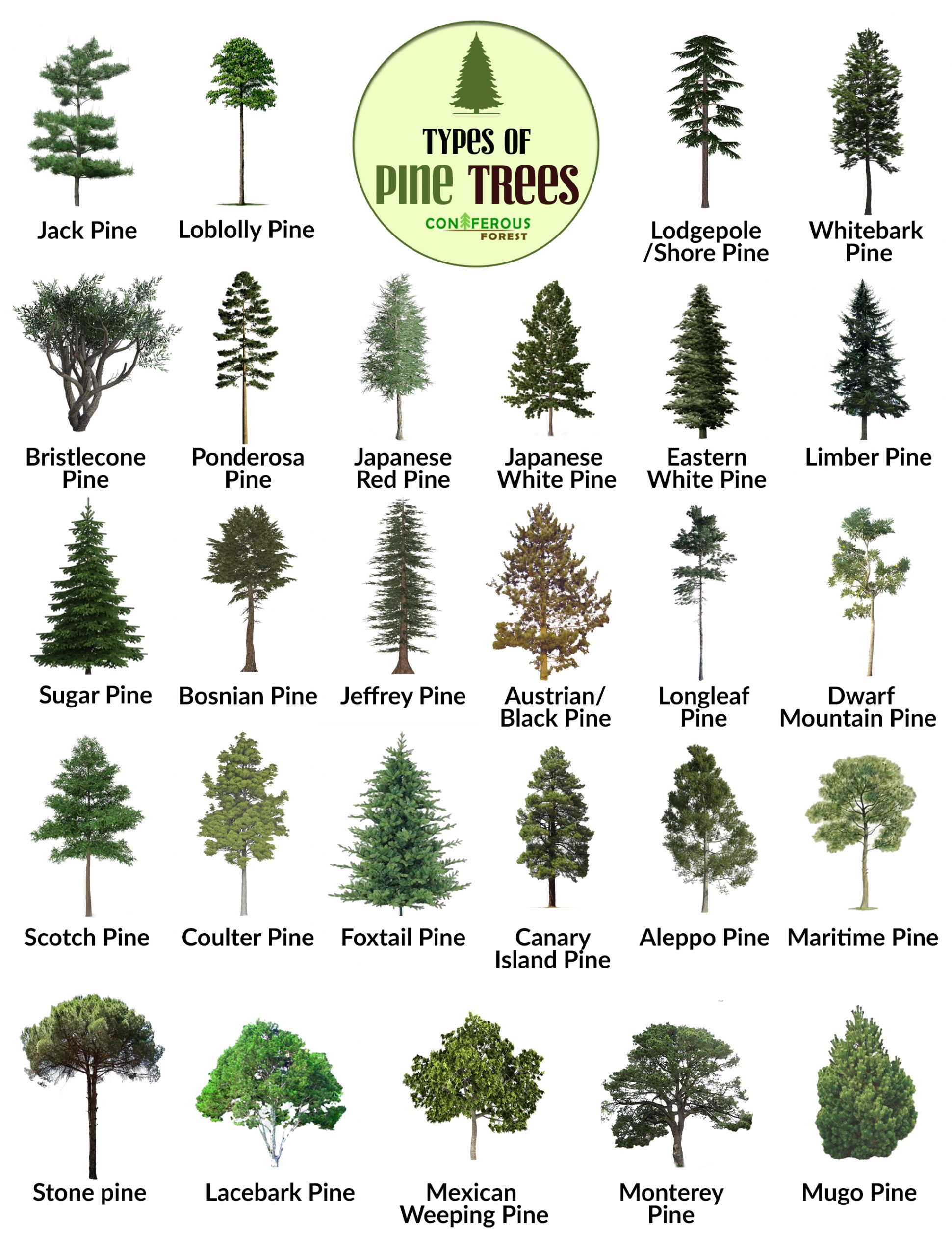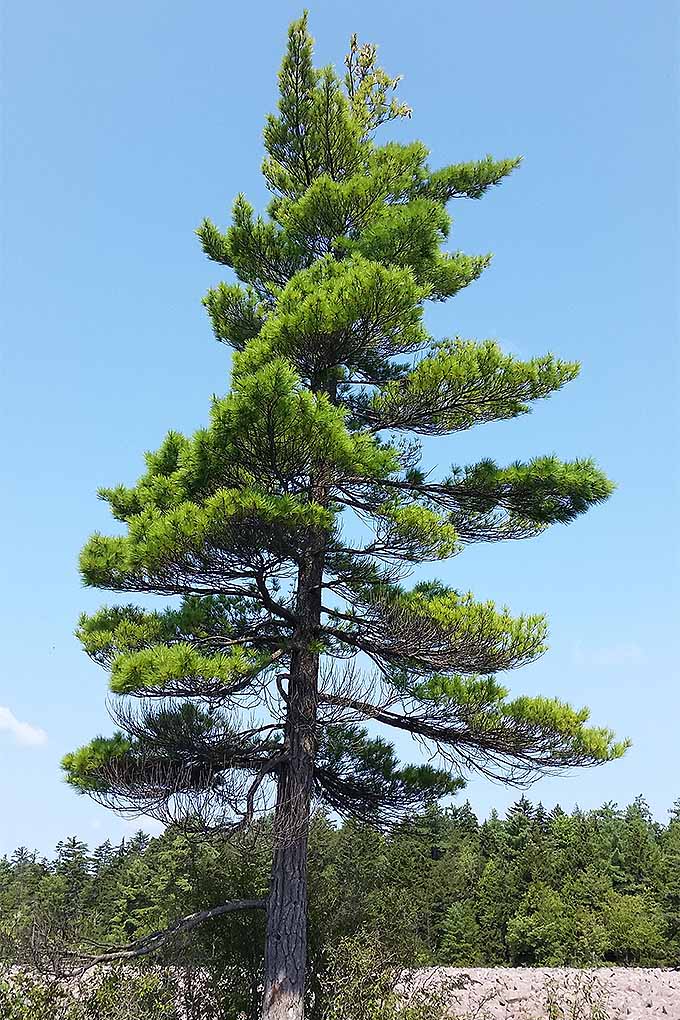Pine
Explore the World of Pine Trees: Types, Identification, and Fascinating Facts
Pine refers to any coniferous tree or shrub belonging to the genus Pinus categorized under the family Pinaceae. Pines are found throughout the world, mainly in the northern temperate regions. Although two pine species may look precisely similar, counting the number of needles in each bundle can help identify them. They have comparatively soft timber, but they are commercially sold as soft (pinyon, sugar, and white) or hard (loblolly, Corsican, and Scotch) pines.
Scientific Classification | |
| Kingdom | Plantae |
| Clade | Tracheophytes |
| Division | Pinophyta |
| Class | Pinopsida |
| Order | Pinales |
| Family | Pinaceae |
| Subfamily | Pinoideae |
| Genus | Pinus |
List of Different Types of Pine Trees
As listed by the Missouri Botanical Garden and Royal Botanic Gardens at Kew, the genus Pinus consists of 126 species and 35 unresolved species. These trees are subdivided into two subgenera distinguished by their leaf, cone, and seed characteristics.
Subgenus Pinus
Some of the common pine species included in this subgenus are given below:
- Sikang pine
- Korean red pine
- Huangshan pine
- Khasi pine
- Masson’s pine
- Mountain pine
- Sumatran pine
- Luchu pine
- European black pine
- Red pine
- Japanese black pine
- Taiwan red pine
- Chinese red pine
- Tropical pine
- Aleppo pine
- Turkish pine
- Canary Island pine
- Bosnian pine
- Chir pine
- Stone pine
- Ponderosa pine
- Gray pine
- Torrey pine
- Jeffrey pine
- Apache pine
- Arizona pine
- Coulter pine
- Lodgepole pine
- Sand pine
- Virginia pine
- Loblolly pine
- Cuban pine
- Spruce pine
- Caribbean pine
- Shortleaf pine
- Longleaf pine
- Chihuahua pine
- Jack pine
Subgenus Strobus
Some of the white and soft pines included in this subgenus are listed here.
- Foxtail pine
- Colorado pinyon
- Mexican pinyon
- Border pinyon
- Weeping pinyon
- Parry pinyon
- Potosi pinyon
- Texas pinyon
- Nelson’s pinyon
- Eastern white pine
- Siberian pine
- Blue pine
- Mexican white pine
- Swiss pine
- Limber pine
- Chinese white pine
- Bhutan white pine
Aside from the different pine species that are mentioned above, several cultivars including ‘Dragon’s Eye’ Korean pine, ‘Oregon Green’ Austrian pine, ‘Watereri’ Scots pine, ‘Nisbet’s Gold’ Scots pine, ‘Joppi’ Jeffrey pine, ‘Cleary’ Japanese white pine, and ‘Winter Sun’ mountain pine have been produced.
Quick Information | |
| Tree Type | Evergreen, coniferous, resinous |
| Identification | Height: 50-260 ft, smallest being the Siberian dwarf pine (3-10 ft) and the tallest being the ponderosa pine (200-268 ft) Leaves: Needle-like adult leaves, bundled in clusters, 1-7 needles per fascicle Trunk Diameter: 1.0-1.6 ft Bark: Thick, scaly, woody outer layer, and a soft, moist inner layer Cones: Small male cones, 1-5 cm long, fall off after shedding the pollens; female cones measure 3-60 cm in length Seeds: Small, winged Branches: Horizontal, either long or short shoots Crown: Conical |
| Distribution | Temperate and subtropical regions in Northern and Southern Hemispheres |
| Habitat | Mountainous areas, semi-arid deserts, rainforests |
| USDA Hardiness Zone | 5-11 |
| Growth Rate | Average, 1-3 feet per year |
| Lifespan | Usually live for 100-1,000, the oldest being a Great Basin bristlecone pine called ‘Methuselah’ that is 4,600 years old |
| Growing Conditions | Sunlight: Full to partial sun Soil: Well-drained, sandy, acidic or alkaline Water: 1 to 3 inches per week |
| Drought Tolerance | Species like Limber, Ponderosa, Mugo, Pinyon, and Bristlecone withstand the dry climate |
| Diseases & Pests | Root rot, gall rust, blister rust, needle rust, Diplodia tip blight, Cyclaneusma needle cast, and Lophodermium needle cast; pests include aphids, caterpillars, borers, weevils, and mealybugs |
| Reproductive System | Monoecious |
| Propagation | From seeds and stem cuttings |
| Wildlife Value | Needles are used as food by several species of moth and butterfly caterpillars; seeds are eaten by jays, crossbills, nutcrackers, grouse, woodpeckers, siskins, and squirrels |
| Uses | Wood is used for construction and making carpentry items, as ornamental trees and Christmas tree; seeds are used for baking and cooking, needles are boiled in water for making tea |
| IUCN Conservation Status | The population of several pine species is decreasing, including the Longleaf pine and Parana pine, which are regarded as endangered and critically endangered respectively |
Interesting Facts
- A group of 400 oddly-shaped pine trees is found in the Crooked Forest located near Gryfino in West Pomerania Province, Poland.
- Pine resin is typically used in Chinese medicine for treating wounds, burns, and other skin conditions.
References
- https://www.britannica.com/plant/pine
- https://conifersociety.org/conifers/articles/10-types-of-pine-trees-that-everyone-should-know/
- https://www.thespruce.com/pine-trees-from-around-the-world-3269718
- http://www.theplantlist.org/tpl1.1/ search?q=pinus
- https://static.colostate.edu/client-files/csfs/pdfs/droughttrees.pdf
- https://extension.psu.edu/pine-diseases
- https://www.iucnredlist.org/species/ 39068/2886222
- https://www.iucnredlist.org/species/ 32975/2829141




